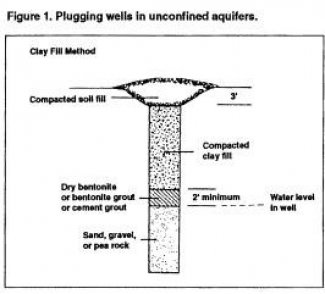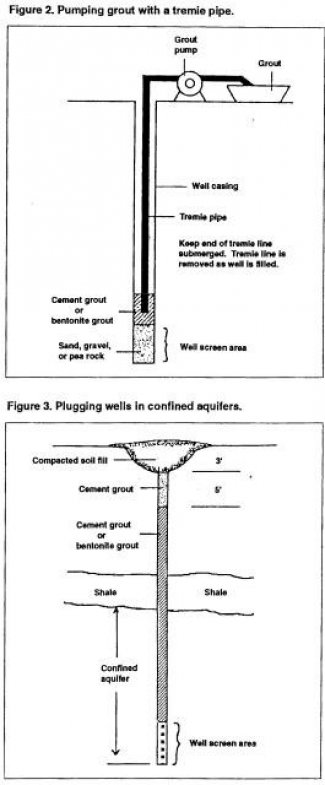Extension Extra
ExEx 1005
Updated April 2002
Agricultural and Biosystems Engineering
COLLEGE OF AGRICULTURE, FOOD & ENVIRONMENTAL SCIENCES / SOUTH DAKOTA STATE UNIVERSITY / USDA
PLUGGING ABANDONED WELLS
Russell Derickson, Extension Water and Natural Resources Specialist
Why seal abandoned wells?
Abandoned wells pose a threat to the safety of animals and humans, especially small children. Unsealed, abandoned wells may act like drains for runoff, allowing contaminated water to flow directly into an aquifer. Sealing abandoned wells by filling them with clay or cement prevents accidents and preserves the drinking water resource.
When must a well be plugged?
A well must be sealed when its original purpose and use have been permanently discontinued, or when its condition is so poor that it cannot be repaired.
Who can plug wells?
Private landowners are permitted to plug their own wells provided they follow procedures established by the state. It is recommended that landowners hire a well driller to plug complex wells, like flowing or non-flowing wells in confined (artesian) aquifers, or wells penetrating multiple aquifers.
Temporary abandonment of wells
A properly conducted well may be temporarily abandoned by seating the well with a water-tight cap.

Plugging wells in unconfined aquifers (water table wells)
1. Fill the well from the bottom to the top of the aquifer (or water table) with clean sand or gravel (Figure 1).
2. Fill the well to within 3 feet of surface with clay, bentonite grout or cement grout.
Note: If clay is used as backfill, place a two-foot layer of dry bentonite, bentonite grout or cement grout above the aquifer and below the clay fill.
3. Remove the top three feet of well casing and fill remaining hole with compacted soil.
For small diameter wells, like sand point wells, it is easier to use cement grout to plug the complete well.

Using a tremie pipe
If the well is more than 50 feet deep or less than 16 inches in diameter, a tremie pipe must be used. A tremie pipe keeps the sealing materials from becoming bridged inside
the well casing and prevents dissolution of liquid grouts. The tremie pipe (or line) must remain submerged and must be raised as the well is filled (Figure 2).
Plugging wells in confined aquifers or multiple aquifers
This applies to artesian wells or wells that encounter more than one aquifer (Figure 3).
1. Fill the well from the bottom to within 3 feet of the surface with cement grout and tremie line.
2. Remove the top 3 feet of well casing and fill the remaining hole with compacted soil.
Alternative method (if well has low artesian pressure):
1. Fill the well from the bottom to within 8 feet of the surface with bentonite grout and tremie line.
2. Fill the next 5 feet with cement grout.
3. Remove the top 3 feet of well casing and fill the remaining hole with compacted soil.
Well-plugging terms
Abandoned well -- Well or test hole whose original purpose and use has been permanently discontinued or a well that is in such a state of disrepair that repairing it is not cost-effective.
Artesian pressure -- Natural pressure that causes water in a well penetrating an aquifer to rise above the top of the aquifer. Flowing wells occur when the pressure is sufficient to force the water above the land surface.
Bentonite -- Highly plastic, colloidal clay composed largely of the mineral montmorillonite that swells upon wetting.
Bentonite grout -- Bentonite and water mixed at a ratio of 1.5 to 2 pounds of granulate bentonite per gallon of water. Bentonite used for grout must be an approved commercially manufactured material designed for plugging or sealing wells.
Clay -- Fine-grained, naturally occurring inorganic material with a very low permeability that doesn't easily transmit water.
Cement grout -- Mixture of high-sulfate-resistant Portland cement and water mixed to a ratio of 1 bag of cement to 6 gallons of water.
Tremie pipe -- Small-diameter pipe placed inside the well casing and used to carry material to the bottom of the well. Tremie pipes prevent bridging of materials and the diluting of liquid grouts.
References
South Dakota Codified Law, Chapter 46-6 (Water Rights); Chapter 74-2-4 (Well Construction Standards).

Issued in furtherance of Cooperative Extension work, Acts of May 8 and June 30, 1914, in cooperation with the USDA. Larry Tidemann, Director of Extension, Associate Dean, College of Agriculture & Biological Sciences, South Dakota State University, Brookings. SDSU is an Affirmative Action/Equal Opportunity Employer (Male/Female) and offers all benefits, services, and educational and employment opportunities without regard for ancestry, age, race, citizenship, color, creed, religion, gender, disability, national origin, sexual preference, or Vietnam Era veteran status.
ExEx 1017 - pdf by CES. August 1993; updated April 2002.

